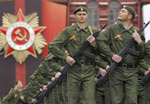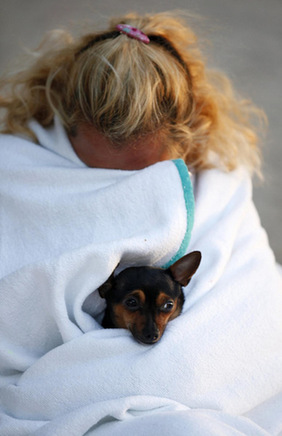Photos
Spaniards fearing aftershocks flee quake city
Updated: 2011-05-13 06:53
(Agencies)
LORCA, Spain - Thousands of Spaniards fled this small agricultural city Thursday, fearing major aftershocks might level it after the country's deadliest earthquakes in 55 years killed nine people and caused extensive damage.
Lorca was transformed into a ghost town, with a steady stream of cars carrying many of its 90,000 residents to nearby cities and towns to stay with relatives. Stores, restaurants, and schools were closed as the sirens of police vehicles and ambulances filled the air and helicopters hovered overhead.
"We can't stay here," Navarro said, his wife sobbing at his side. "We're going to stay with relatives."
Only a few people walked the streets. Tens of thousands spent the night outside in makeshift camps, and many of those who remained were poor Latin American immigrants who work the fields and had nowhere else to go.
Though Spain's government promised to set up a shelter to house 3,500 people, Luis Vazquez was camping in a supermarket parking lot with his wife, 12-year-old daughter and four other families.
The unemployed Ecuadorean farm worker said his apartment was badly damaged, and that he would soon "have to ask for help if it continues like this. I can't care for my family without money, and now without a house."
Thirty people remained hospitalized Thursday, a day after the two quakes, which prompted an estimated 30,000 residents to sleep in cars, shelters fashioned from cardboard boxes and lawn chairs at makeshift camps in parks in the city about 30 kilometers (19 miles) inland from Mediterranean Sea beach destinations where little to no damage was reported.
Only a few buildings were destroyed, but the quakes with magnitudes of 4.5 and 5.1, according to figures updated Thursday evening by Spain's National Geographic Institute, sent brick building facades and parts of terraces plunging into the streets and caused damage to hundreds of apartment buildings. While some people couldn't stay home, many others didn't want to stay inside for fear of aftershocks.
"The whole facade and the stairs of the apartment where I live are totally broken," said resident Tomas Hinojo. "The hardest things happened right where I live. Three of the victims killed are my neighbors."
The Spanish institute said the second, larger quake was followed by 37 aftershocks lasting through Thursday morning. The largest was about half an hour after midnight and measured 3.9.
Spanish experts said the second quake caused the most damage, and its power was more destructive than many quakes of similar magnitude because its epicenter was on the outskirts of Lorca and because it happened at the very shallow depth of about 1 kilometer (0.6 miles) below ground.
"That is very, very close to the surface," said Maria Jose Jurado Rodriguez, a geologist with the Spanish National Research Council, the government's top scientific research group. "That energy goes very directly to the inhabited area."
The soil in the Murcia region where Lorca lies is loose and sandy, meaning it could not absorb earthquake energy as well as places that have more compact soil, said Ramon Aragon Rueda, head of the Murcia branch of the government's Geological and Mining Institute.
Another Ecuadorean resident of Lorca, Edison Tixd, said he thought terrorists had hit the city when the quakes struck.
"I thought it was a bomb by al-Qaida after what happened to (Osama) bin Laden," said Tixd, 26. "The sound was spine-chilling."
The dead included one child, three of those hospitalized were in serious condition, and an additional 260 were treated for light injuries and shock immediately after the quakes, the regional government's health department said.
Lorca was filled with cars crushed by rubble and buildings scarred with cracks as government teams of architects and surveyors fanned out throughout the city, inspecting buildings and painting them with color codes.
Red was for dangerous and uninhabitable buildings, yellow to warn residents to take caution when entering and green for safe structures. There were few red marks, but many buildings painted yellow and green stood abandoned.
A team of 200 architects and engineers have surveyed about 550 buildings in the most damaged areas of the city. A total of 17 percent have structural damage, 38 percent require residents to take caution upon entering and the rest are undamaged, said the Lorca town councilor responsible for public works, Jose Ballesta. He added that a red sticker does not necessarily mean, however, that the building will be condemned.
About 5,000 people were expected to spend the night in makeshift camps set up in Lorca, Mayor Francisco Jodar said.
In one of the most dramatic images from the quake replayed over and over on Spanish television Thursday, chunks of stones and brick fell from the bell tower of the San Diego church in the city center as a reporter for Spanish state TV was broadcasting live from the scene. The church's bell also crashed down, just missing the reporter.
Lorca also suffered quakes of roughly the same magnitude in 1999, 2002 and 2005 that caused damage, but no injuries.
Prime Minister Jose Luis Rodriguez Zapatero halted campaigning for regional and municipal elections to oversee an emergency committee to coordinate rescue and aid operations, and made a special appearance in congress on Thursday to express condolences.
Eight hundred police and soldiers were deployed to the city to assist with the cleanup, but Zapatero warned that the process won't be quick.
"We have a lot of work ahead of us," he said. "The task is very, very intense."
The quakes were the nation's most deadly since 1956, when 12 people died and about 70 were injured in the southern Granada region, according to Spain's National Geographic Institute.
Lorca has a mix of older buildings vulnerable to earthquakes and newer ones built after Spain put earthquake-resistance measures into its building code in the 1960s.
Lorca has roots dating back to Roman times and is noted for its hilltop medieval fortress and other historic buildings. Its economy depends on agriculture, and thousands of immigrants from North Africa and Latin American nations are employed as farm workers.
The quakes happened on the same day that Italians feared a quake that never materialized.
No single fault or series of faults link Wednesday's Spain earthquakes to Rome - though all of Italy, southern Spain and Turkey are seismically active zones due to the European and African tectonic plates moving against one another, Bellini said.
E-paper

War of the roses
European Chinese rose growers are beating their Chinese rivals at their own game
Preview of the coming issue
High-tech park gets big boost
At the source
Specials

New wave
Coastal city banks on marine sector to ride next stage of economic development

Drunk driving
Drunk drivers face a detention for one to six months and a revokation of their drivers' license.

V-Day parade
A military parade marking the 66th anniversary of the Soviet victory over Nazi.

